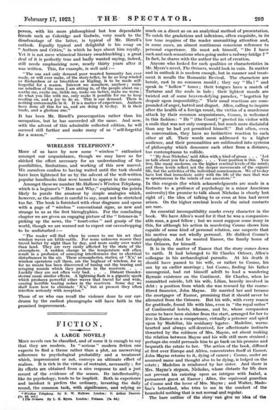WIRELESS TELEPHONY.* MOST of us have by now some "
wireless " enthusiast amongst our acquaintance, though we may have so far shirked the effort necessary for an understanding of the possibilities, limitations, and working of this new marvel. We ourselves confess to having waited until the task should have been lightened for us by the advent of the well-written popular handbooks that were bound to appear in due course.
Amongst these we number Mr. Hallows's Wireless Telephony, which is a beginner's " How and Why," explaining the points likely to puzzle the amateur by simple analogies which, however, as the author is careful to say, must not be stretched too far. The book is furnished with clear diagrams and opens with a page of " wireless " conventional signs, as new and strange to us as the first hieroglyphics. For the concluding chapter we are given an engaging picture of the " listener-in " picking up the news, the " heart-cries " and gossip of the world, though we are warned not to expect our eavesdropping to be undisturbed :—
" The reader will find when he comes to use his set that wireless waves are kittle-cattle. For some unknown reason they travel better by night than by day, and more easily over water than land. They are very easily affected by the state of the atmosphere. A sudden change in the temperature will often result in a profusion of annoying interferences due to electrical disturbances in the air. These atmospherics, statics, or X's,' as wireless operators call them, are the bugbear of wireless, for so far no means has been discovered of tuning out the tearing and scraping sounds which they produce in the receivers. . . . Luckily they are not often very bad. . . . Distant thunder. storms cause similar effects. A lightning flash is a gigantic spark which produces powerful ether waves that travel far and wide, causing horrible tearing noises in the receivers. Some day we shall learn how to eliminate X's,' but at present they often interfere seriously with reception."
Those of us who can recall the violence done to our ear- drums by the earliest phonographs will have faith in the promised improvement.










































 Previous page
Previous page